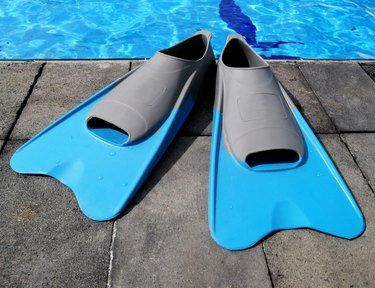

Goggles and a swimsuit are go-tos when you want to spend a day at the pool, but if you're trying to improve your swimming technique, you want to consider investing in a pair of swimming fins, too.
You don't need to be snorkeling or deep-sea diving to enjoy the benefits of swimming fins. Even recreational swimmers can enjoy what they have to offer.
Video of the Day
Video of the Day
Read on to learn all the pros and cons of swimming with fins and how to incorporate them into your next swim workout.
3 Benefits of Swimming With Fins
1. Improved Swimming Technique
Although it may seem counterintuitive, swimming with fins can actually help improve your swim technique, thanks to the extra power flippers provide, according to Garret Seacat, CSCS, a triathlon and cycling coach at Absolute Endurance.
Using swim fins helps you raise and keep your hips higher because it takes less effort to paddle. This improves your overall posture, he says. It also helps reinforce the importance of using your legs to propel you forward in the water.
Practicing with fins can help improve your swimming and kicking technique so when you hit the water with no equipment, form comes more easily.
2. Tougher Workouts
If you're swimming with flippers for weight loss, they're a helpful tool for adding some resistance to your swim workout, according to Swim England Masters.
Using swim fins makes it harder to move your legs in the water compared to swimming without fins. As a result, you'll recruit more muscle to keep you afloat when you kick hard, and ultimately, burn more calories. In short, they increase the overall strength and cardio challenge of your swim session.
3. Better Ankle Flexibility
Swim fins may also help improve your ankle flexibility, according to Seacat. When you swim, you need to extend your ankle so that your toes and shin form a straight line. But this can be tough if you don't have enough flexibility in your ankles.
Because they add a little resistance as you paddle, swim fins can give you a better feeling of how your feet move through the water, improving flexibility in your ankles.
The 4 Best Swimming Fins to Try
- FINIS Long Floating Fins (Amazon.com, $23.95)
- Belyfuko Short Swim Fins (Amazon.com, $27.99)
- FINIS Training Swim Fins (Amazon.com, $30.40)
- Seaview 180 RAWA Snorkel Fins (Amazon.com, $39.99)
3 Cons of Swimming With Fins
1. Blisters
One big downside of swimming flippers? There's a pretty high likelihood of developing blisters, especially when you first start using them, Seacat says. These can make your swim feel uncomfortable and, if they tear open, they can become infected.
"Be cautious and slowly work yourself into using them," he says.
You can also try to prevent blisters by wearing socks under your fins. This might be tough if your fins are super tight, but it will work well if your fins are just a little big.
2. Dependence
Fins can be a great tool while developing your swimming technique and form, but you don't want to become dependent on them, according to Seacat. Although flippers for swimming can increase the challenge of your workout and improve your ankle motion, you still want to practice swimming without fins, too.
"They are a tool and should be used as part of your workout," he says. "But too much use can make swimming without them feel foreign."
A good tip? Schedule drills that involve fins and fin-free swimming in the pool.
3. Costs
Swim fins are not only an investment (don't worry, we've found some affordable options for you above), but you might need to buy a variety of flippers, depending on your workout. While shorter fins are better for fast, sprint-style training to develop power, longer flippers are ideal for endurance-focused, open-water swimming.
Plus, wearing an ill-fitting pair may cause them to slip off your feet mid-workout, so make sure you purchase a pair that's the right fit and is comfortable.
What's a Better Swimming Workout: With Fins or Without?
Unfortunately, there's no clear winner here — one isn't necessarily better than the other. There are pros and cons to swimming with fins.
For example, swimming with flippers is a great way to develop your technique, build some strength, burn more calories and increase your ankle flexibility.
That said, they can take away from developing your natural swimming technique if you rely too much on them. (It's worth noting you don't have to wear fins for your whole workout either.) However, you won't necessarily always have fins readily available, either.
Bottom line: It's best to have a balance of swimming with and without fins. You can (and should) enjoy swim fins benefits, while improving your swimming form and speed without the help of additional tools.